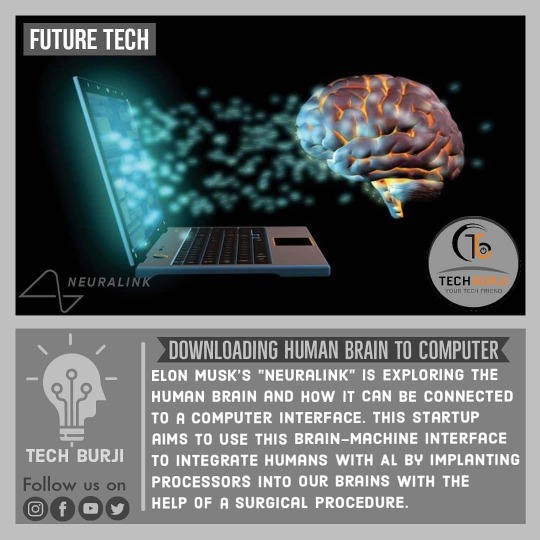#brainmachineinterface
Explore tagged Tumblr posts
Text
#1169 How would a brain machine interface work?
How would a brain machine interface work? A brain machine interface would work by reading the brain’s electrical signals and converting them into a signal that a machine can use. They could be worn on the head or implanted in the brain. At its simplest level, the brain machine interface is just reading the electricity in the brain. Everything our brain does, from thinking to moving muscles, comes down to electrical signals. For example, if you want to pick up a coffee cup, the decision is made in the cerebrum part of the brain. The brain then analyzes other signals, such as sight, to work out where the cup is and decide what is involved in picking it up. Then the signals to pick the cup up are transmitted across the neurons to the nervous system and on to the muscles, where they make the muscles contract. The idea behind the brain machine interface is that something on or in the brain picks up these electrical signals and broadcasts them to a device. That sounds much easier to say than it is to do. There are two kinds of brain machine interface devices. There are invasive ones that are implanted into the brain and there are non-invasive ones, which are worn on top of the head. Currently, the main function of brain machine interfaces is to allow people without mobility to use devices or to communicate, or to be able to control a bionic limb. Chips have been surgically implanted into a patient with paralysis to allow them to move a computer mouse by thinking about it. Invasive interfaces are better because they are closer to the brain and can pick up the electrical signals more clearly while the non-invasive ones have to read the signal through the skull, so it is not as strong. However, there is a lot of risk involved with implanting a chip into the brain and there can be a lot of scar tissue. There is also the risk that the body will reject the chip and there will be an immune response. Brain machine interfaces use sensors that pick up the electrical activity in the brain and then analyze it. They can pick it up by just being near the brain and working out which part of the brain is firing, or they can be implanted into the brain. This gives the best signal, but the damage to the brain will cause scar tissue around the neurons until the sensors can no longer pick them up. The signal is picked up and sent to the microchip where machine learning tries to work out what the signal means. This is done with neural decoding software, which tries to learn with feedback. These devices can help people move exoskeletons and robotic limbs, but they can also help people who have had strokes or other debilitating brain injuries to speak. Currently, a brain chip developed by Stanford University can read the signals from a patient’s brain well enough to translate them into 62 words a minute, which is conversation speed. That means people who have lost the power of speech, such as people suffering from locked-in syndrome can still talk. These devices sound amazing, but it takes a lot of practice to get them to work and there is a steep learning curve. The microchip that can translate what someone is trying to say into words is not hearing that person’s thoughts. It is watching the electrical signals and trying to match those signals to a database of words that it has. The person will need to teach the system which words they are trying to say in the beginning, and the microchip will slowly learn until it can translate much faster. The first step is trying to make devices that can help people with disabilities, and it goes both ways. Experiments show that signals can be taken from the brain and translated into an action, but signals can also be fed into the brain. If someone has lost their sight, perhaps because of an injury to their eyes, the part of the brain that analyzes sight is still working. A device was made that sent signals from glasses fitted with a camera into the brain and the brain could interpret them as images. The images were not great, but it is still early days. The next step might be brain implants for all of us that allow us to manipulate devices just by thinking. If that happens, have we become telekinetic? And this is what I learned today. Liked this? Read these: - #546 How does a cochlear implant work? - #304 Why can we only hear certain frequencies? - #128 Does Moore's Law still apply today? - #1126 How does the magnetic strip on a credit card work? - About me Sources https://cumming.ucalgary.ca/research/pediatric-bci/bci-program/what-bci https://en.wikipedia.org/wiki/Braincomputer_interface https://builtin.com/hardware/brain-computer-interface-bci https://my.clevelandclinic.org/health/body/23083-cerebrum Read the full article
0 notes
Text
IBM, Inclusive Brains Use AI and Quantum for BMI Research

Inclusion Brains
IBM and Inclusive Brains Improve Brain-Machine Interfaces with AI, Quantum, and Neurotechnologies
IBM and Inclusive Brains have partnered to study cutting-edge AI and quantum machine learning methods to improve multi-modal brain-machine interfaces (BMIs). On June 3, 2025, this agreement was launched to improve brain activity classification.
This collaborative study seeks socially beneficial innovation. BMIs may help people with disabilities, especially those who cannot use their hands or voice, regain function. By letting people control linked devices and digital settings without touching or speaking, BMIs can help patients regain control. With this study's findings, Inclusive Brains aims to expand educational and career prospects. In addition to aiding crippled people, the alliance wants to improve brain activity classification and understanding to help the public avert physical and mental health issues.
IBM AI and quantum expertise will strengthen Inclusive Brains' multimodal AI systems in the collaboration endeavour. The real-time customisation of BMIs to each user's needs and talents is being developed to increase autonomy and agency.
Comparing brain activity categorisation accuracy to current models is a major investigation phase. Using IBM Granite foundation models to generate, review, and test code helps determine the best machine learning algorithmic combinations for brain activity classification and interpretation. The project will also examine automatic selection of the optimal algorithms for specific users and their use in “mental commands” to control workstations.
The terms “mental commands,” “mind-controlled,” and “mind-written” are simplified for this study. They don't mean brainwaves read words or commands. A multimodal AI system learns from brainwaves, eye movements, facial expressions, and other physiological data. These mixed signals help the system determine human intent and operate without touch or speech.
The alliance plans several open science research publications to benefit scientists and the public. The study will also investigate quantum machine learning brain activity classification. Both organisations are committed to ensuring the study follows responsible technology principles, which include ethical concerns and neurotechnology and neurological data usage recommendations.
IBM France president Béatrice Kosowski is happy to engage with innovative firms like Inclusive Brains and responsibly provide access to IBM's AI and quantum technologies to promote healthcare.
Professor Olivier Oullier, CEO and co-founder of Inclusive Brains, said the collaborative study will assist generate highly customised machine-user interactions, signifying a shift towards unique solutions that meet each person's needs, body, and cognitive style. Inclusive Brains has demonstrated multimodal interface Prometheus BCI through public “mind-controlled” acts like tweeting, writing a parliamentary amendment, and using an arm exoskeleton.
In the last decade, BMIs have become more prevalent since they connect the brain to a computer, usually for controlling external equipment. They are useful for studying brain physiology, including learning and neuronal behaviour, as well as restoring function. This collaborative study will improve these fascinating technologies' capabilities and accessibility.
In conclusion
IBM and Inclusive Brains investigated BMI technology. The collaboration uses cutting-edge AI and quantum machine learning to classify brain activity patterns. Enabling “mental commands” based on physiological signals aims to promote disability accessibility and inclusion. Ethics and responsibility in neurotechnology use are also stressed in the study.
#InclusiveBrains#brainmachineinterfaces#IBMandInclusiveBrains#multimodalAI#neurotechnology#QuantumInclusiveBrains#technews#technologynews#news#govindhtech
0 notes
Text
Elon Musk's Vision: Electric Cars, Mars Settlement, and Brain-Machine Interfaces #brainmachineinterfaces #CEO #electriccarsales #ElonMusk #emergingindustries. #humansettlementonMars #neuralink #neurotechnologystartup #productioncapacity #Raptorrocketengine #reusablerockets #spacex #Tesla
#Business#brainmachineinterfaces#CEO#electriccarsales#ElonMusk#emergingindustries.#humansettlementonMars#neuralink#neurotechnologystartup#productioncapacity#Raptorrocketengine#reusablerockets#spacex#Tesla
0 notes
Video
youtube
Elon Musk’s Brain Implant Company: Connecting Human Minds to the Internet
#youtube#ElonMusk BrainImplant Neuralink InternetConnectivity HumanMinds BrainMachineInterface BMI Technology Innovation Neuroscience HumanComputerIn
0 notes
Text
Wireless Brain-Machine Interfaces Market: Expanding from $1.2B to $6.5B by 2034
Wireless Brain-Machine Interfaces (BMI) Market is set to grow from $1.2 billion in 2024 to $6.5 billion by 2034, achieving a CAGR of 18.5%. These cutting-edge systems enable seamless brain-to-device communication, transforming healthcare, neuroprosthetics, gaming, and cognitive research.
To Request Sample Report: https://www.globalinsightservices.com/request-sample/?id=GIS11158 &utm_source=SnehaPatil&utm_medium=Article
Market Trends & Key Segments
🧠 Neurorehabilitation leads the market, offering breakthrough treatments for neurological disorders. 🎮 Gaming & entertainment is the second-fastest-growing segment, enhancing immersive experiences. 📡 Wireless EEG and fMRI technologies are revolutionizing real-time neural signal processing.
Regional Insights
🇺🇸 North America dominates, with strong R&D investments and major players like Neuralink. 🇪🇺 Europe follows, driven by government funding and neurotech advancements. 🌏 Asia-Pacific is an emerging hotspot, fueled by increasing investments in brain-computer interface (BCI) research.
Market Segmentation Breakdown
🔹 By Type: Invasive (55%), Non-Invasive (30%), Partially Invasive (15%). 🔹 By Product: Headsets, Implants, Neural Signal Processing Units. 🔹 By Technology: EEG, ECoG, fMRI, NIRS. 🔹 By Application: Healthcare, Gaming, Smart Home Control, Defense. 🔹 By Key Players: Neuralink, Kernel, Synchron are driving industry innovation.
Growth Drivers & Future Outlook
✅ Advancements in AI-powered neural signal decoding. ✅ Rising adoption in neuroprosthetics & mental health applications. ✅ Integration with AR/VR for next-gen human-computer interaction.
The future of brain-machine interfaces is wireless, intuitive, and transformative, unlocking unprecedented possibilities in neuroscience and beyond.
📢 The next evolution of human connectivity is here!
#BrainMachineInterface #WirelessTech #Neurotech #AIinHealthcare #NeuralEngineering #Neuroscience #WearableTech #MindControl #CognitiveEnhancement #EEG #BrainWaves #Neuroprosthetics #SmartWearables #HumanAugmentation #HealthcareInnovation #NeuroRehab #BCITech #Neuralink #BrainData #NeuroScienceRevolution #MentalHealthTech #BrainToComputer #FutureOfTech #NeuralInterfaces #NeuralSignalProcessing #GamingTech
0 notes
Photo

Neuralink- cyborgs, cybernetics, and transhumanism. It is time. Elon Musk’s recently made an announcement that his company Neuralink will seek to implant a microchip into the human brain 🧠 through a neuro lace. Considering the advancements of AI and robotics, Elon states that his main goal is to create “a symbiosis with AI” thus potentially creating a new class of humans. Since this technology will most likely be available to the wealthy, it could most likely give them access to more resources. . The creation of this new field of cybernetics would open doors to many new areas of research such as the development of neuro pharmaceuticals to prevent glial scarring that can occur in the brain in the presence of chronic implants. . In addition with Google, Microsoft, and GPU development from NVIDIA and AMD, these cybernetic organisms called cyborgs could create and have access to virtual worlds that we can only dream of right now. . Credit: DTaylor/Heisenberg / CC BY 2.0 and econocom. . #neuralink #elonmusk #cyborg #cybernetics #brainmachineinterface #futurism #neuroscience #brainimplants #cyborgs #consciousness #virtualworlds https://www.instagram.com/p/B0JP_MEhzxG/?igshid=1qfv47m0a9zsd
#neuralink#elonmusk#cyborg#cybernetics#brainmachineinterface#futurism#neuroscience#brainimplants#cyborgs#consciousness#virtualworlds
2 notes
·
View notes
Text
Typing at the Speed of Thought
Typing quickly and accurately without thinking about typing is called "Typing at the speed of Thought." It requires muscle memory and practice. This skill is valuable in today's fast-paced world, especially for computer workers who need to type a lot. Technology advancements offer great potential for the future of typing at the speed of thought. It can enhance productivity and revolutionize how we use technology.
#training#TypingAtTheSpeedOfThought#Productivity#TouchTyping#Neuroplasticity#BrainTypingConnection#Mindfulness#Visualization#BCIs#VirtualReality#AugmentedReality#UltraInstinct#FutureTechnology#IncreaseProductivity#ErgonomicKeyboard#BrainMachineInterface#Neuralink
1 note
·
View note
Photo

Follow us to explore future tech 💡 @tech_burji @tech_burji . . #futuretech #futuretechnology #techfreak #elonmusk #neuralink #elonmusknews #technews #california #brainmachineinterface #technical #artificialintelligence #technopeople #creativetechnology #techforeveryone #explore #brain #braintech #exceptional #computer #computertech (at San Francisco, California) https://www.instagram.com/p/B_bnemtDnU7/?igshid=2w6hjn2wo92x
#futuretech#futuretechnology#techfreak#elonmusk#neuralink#elonmusknews#technews#california#brainmachineinterface#technical#artificialintelligence#technopeople#creativetechnology#techforeveryone#explore#brain#braintech#exceptional#computer#computertech
0 notes
Video
instagram
Top floor training - master NLP Brainwave recorded with Brainmachine #Brainmachine_IBVA #eeg #brainmachineinterface #medicalartist #scienceandart #artsmeetscience #sciart #neurofeedbacktraining #neurofeedback #richardbandler www.brainmachine.co.uk (at Four Points by Sheraton Orlando International Drive) https://www.instagram.com/p/BraSOn3lHjF/?utm_source=ig_tumblr_share&igshid=ovf9a08fkjo0
#brainmachine_ibva#eeg#brainmachineinterface#medicalartist#scienceandart#artsmeetscience#sciart#neurofeedbacktraining#neurofeedback#richardbandler
0 notes
Photo

Research moves closer to brain-machine interface autonomy
Findings allow for the development of an autonomously updating brain-machine interface, which is able to improve on its own by learning about its subject without additional programming. The system could help develop new robotic prosthetics, which can perform more naturally.
#robotics #neurobotics #robots #neurobots #ai #artificialintelligence #deeplearning #machinelearning #autonomy #neurotech #prosthetics #neuroprosthetics #neuroscience #science #brainmachineinterface
#robotics#neurobotics#neurobots#robots#autonomy#brain machine interface#deep learning#machine learning
26 notes
·
View notes
Photo

The Current State of Neuroscience http://ehelpdesk.tk/wp-content/uploads/2020/02/logo-header.png [ad_1] [ad_2] #allensaakyan #bci #bmi #braincomputerinterface #brainhealth #brainmachineinterface #brainmind #childhooddevelopment #confidence #consciousness #defaultmodenetwork #depression #emotionalintelligence #energyhealing #healthybrain #leadership #learningstrategies #lifecoaching #memory #mindfulness #neuralinterface #neuralnetworks #neuralprosthetic #neuro-linguisticprogramming #neuroaugmentation #neurodegeneration #neuroethics #neurology #neuropathy #neuroplasticity #neuroscience #neurotech #neurotechnology #parenting #parkinsons #personaldevelopment #personalproductivity #psychedelics #ptsd #publicspeaking #quantummechanics #reiki #science #simulation #simulationseries #speedreading #stocktrading #technicalanalysis #technology
0 notes
Text
#BiomedicalEngineering: scientists created a highly efficient #memristor-based neural signal analysis system for identifying neural signals and brain states. The memristor-based system could facilitate the design of next-generation #BrainMachineInterfaces https://t.co/2qoQXE5ILv https://t.co/bVZf3q1GnQ
#BiomedicalEngineering: scientists created a highly efficient #memristor-based neural signal analysis system for identifying neural signals and brain states. The memristor-based system could facilitate the design of next-generation #BrainMachineInterfaces https://t.co/2qoQXE5ILv pic.twitter.com/bVZf3q1GnQ
— The Royal Vox Post (@RoyalVoxPost) August 25, 2020
via Twitter https://twitter.com/RoyalVoxPost August 25, 2020 at 01:09PM
0 notes
Link
Posted by DeleuzeChaosmos via /r/artificial. Join Discussion: https://ift.tt/2K3Cjpu. Curated by: www.eurekaking.com
0 notes
Link
via Twitter https://twitter.com/justin_aptaker
0 notes
Text
#BrainMachineInterface #NeuroInformatics : New method manages and stores data from millions of nerve cells – in real time - https://t.co/8Ofptgfunb 📷: Ljungquist/Petersson/Johansson/Schouenborg/Garwicz https://t.co/avAmcfeiWP
#BrainMachineInterface #NeuroInformatics : New method manages and stores data from millions of nerve cells – in real time - https://t.co/8Ofptgfunb 📷: Ljungquist/Petersson/Johansson/Schouenborg/Garwicz pic.twitter.com/avAmcfeiWP
— The Royal Vox Post (@RoyalVoxPost) March 19, 2018
via Twitter https://twitter.com/RoyalVoxPost March 19, 2018 at 03:20PM
0 notes
Text
Researchers train monkeys to mind-control a wheelchair
A team of scientists at Duke University have developed a wheelchair that is controlled exclusively by the thoughts of its user -- in this case, one of two lab monkeys -- and have published their findings in the journal Scientific Reports. The prototy...
Original post: SlashGear
Fast Laptop and PC Repair Service 7/24: http://londonpcrepairs.org.uk/about-us/
More: http://londonpcrepairs.org.uk/researchers-train-monkeys-to-mind-control-a-wheelchair/
0 notes